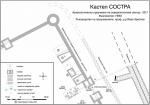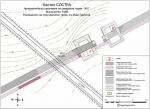Summary (English)
SOSTRA (Ivan Hristov – ivchristov70@abv.bg) The explorations were carried out in the northeastern sector of the castellum. A line of military barracks of the 2nd century AD were documented close to via praetoria to the west of the eastern fortification gate. Building No. 3 was situated close to the northern fortification tower of the eastern gate and adjoined the inner side of the fortification wall. The finds included red-gloss sherds, bronze Roman provincial coins and denarii of Septimius Severus and Philip the Arab, a posthumous copper coin of Claudius Gothicus, a fibula. Via sagularis was discovered beneath a layer with traces from fire, dated by an as and a denarius of Trajan and an as of Faustina the Younger. Building No. 9 measured 4.60 m by 6.20 m and was constructed in rubble masonry with an upper part built of sun-dried bricks. It was situated at 3.90 m to the west of the inner side of the fortification wall. The finds included sherds, bronze Roman provincial coins of Caracalla, Macrinus and Gordian III, a copper coin of Maximian, copper coins of the AD 370s – 380s. Building No. 4 measured 9.60 m by 4 m, constructed of roughly-cut stones and situated at 7 m to the north of Building No. 9. Its walls were preserved at almost 3 m in height, including part of the second floor. The finds included Late Antique sherds, denarii and bronze Roman provincial coins of Macrinus and Gordian III, copper coins of Valentinian I and Valens. The two towers that flanked the northern fortification gate were rectangular, situated at 5.30 m from each other, while the gate was 3 m wide. The towers were additionally built at the fortification wall at the end of the 4th century AD, just before the Gothic invasions. The western wall of the western tower was 2 m wide, while its other walls were 1 m wide. Late Antique sherds and coins of the end of the 4th – first half of the 5th centuries AD were found in the eastern tower. A bronze coin of Probus was found in the mortar of the fortification wall. During the previous excavations, a number of copper coins of Claudius Gothicus and Aurelian were discovered in the mortar of the fortification walls and towers. These coins indicated the date of the construction of the fortification.
- Ivan Hristov - National Museum of History
Director
Team
Research Body
- National Museum of History






![Download [PDF]](/excavation/skins/fasti/images/results/download_sml.png)
